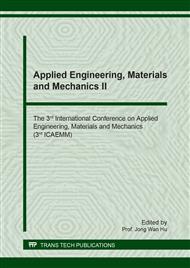[1]
A. Majumdar, Thermoelectricity in semiconductor nanostructures, Science 303 (2004) 777-778.
DOI: 10.1126/science.1093164
Google Scholar
[2]
C. B. Vining, Semiconductors are cool, Nature 413 (2001) 577-578.
Google Scholar
[3]
H. J. Goldsmid, Bismuth Telluride and Its Alloys as Materials for Thermoelectric Generation, Materials 7 (2014) 2577-2592.
DOI: 10.3390/ma7042577
Google Scholar
[4]
B. Poudel, Q. Hao, Y. Ma, Y. Lan, A. Minnich, B. Yu, X. Yan, D. Wang, A. Muto, D. Vashaee, X. Chen, J. Liu, M. S. Dresselhaus, G. Chen, Z. Ren, High-thermoelectric performance of nanostructured bismuth antimony telluride bulk alloys, Science 320 (2008).
DOI: 10.1126/science.1156446
Google Scholar
[5]
S. J. Hong, B. S. Chun, Microstructure and thermoelectric properties of extruded n-type 95%Bi2Te2–5%Bi2Se3 alloy along bar length, Mater. Sci. Eng. A 356 (2003) 345-351.
DOI: 10.1016/s0921-5093(03)00147-3
Google Scholar
[6]
Y. Du, K. F. Cai, H. Li and B. J. An, The influence of sintering temperature on the microstructure and thermoelectric properties of n-type Bi2Te3−xSex nanomaterials, J. Electron. Mater. 40 (2011) 518-522.
DOI: 10.1007/s11664-010-1424-9
Google Scholar
[7]
S. Wang, W. Xie, H. Li and X. Tang, Enhanced performances of melt spun Bi2(Te,Se)3 for n-type thermoelectric legs, Intermetallics 19 (2011) 1024-1031.
DOI: 10.1016/j.intermet.2011.03.006
Google Scholar
[8]
F. Li, X. Huang, Z. Sun, J. Ding, J. Jiang, W. Jiang and L. Chen, Enhanced thermoelectric properties of n-type Bi2Te3-based nanocomposite fabricated by spark plasma sintering, J. Alloys Compd. 509 (2001) 4769-4773.
DOI: 10.1016/j.jallcom.2011.01.155
Google Scholar
[9]
P. F. P. Poudeu, J. D'Angelo, A. Downey, J. L. Short, T. P. Hogan and M. G. Kanatzidis, High Thermoelectric Figure of Merit and Nanostructuring in Bulk p‐type Na1−xPbmSbyTem+2, Angew. Chem. 118 (2006) 3919-3923.
DOI: 10.1002/ange.200600865
Google Scholar
[10]
Y. S. Lim, S. -M. Wi, G. G. Lee, Synthesis of n-type Bi2Te1-xSex compounds through oxide reduction process and related thermoelectric properties, J. Eur. Ceram. Soc. 37 (2017) 3361-3366.
DOI: 10.1016/j.jeurceramsoc.2017.04.020
Google Scholar
[11]
S. T. Han, P. Rimal, C. H. Lee, H. S. Kim, Y. Sohn and S. J. Hong, Enhanced thermoelectric cooling properties of Bi2Te3−xSex alloys fabricated by combining casting, milling and spark plasma sintering, Intermetallics 78 (2016) 42-49.
DOI: 10.1016/j.intermet.2016.08.006
Google Scholar
[12]
Z. Rong, X. Fan, F. Yang, X. Cai, X. Han and G. Li, Microwave activated hot pressing: A new opportunity to improve the thermoelectric properties of n-type Bi2Te3-xSex bulks, Mater. Res. Bull. 83 (2016) 122-127.
DOI: 10.1016/j.materresbull.2016.05.030
Google Scholar
[13]
H. Scherrer, R. Martin-Lopez, B. Lenoir, A. Dauscher, S. Scherrer, Thermoelectric materials of p and n type from the (Bi,Sb,Te) phase diagram, Proc. 20th Int. Conf. Thermoelectr. (2001) 13-17.
DOI: 10.1109/ict.2001.979606
Google Scholar
[14]
O. Yamashita, S. Tomiyoshi and K. Makita, Bismuth telluride compounds with high thermoelectric figures of merit, J. Appl. Phys. 93 (2003) 368-374.
DOI: 10.1063/1.1525400
Google Scholar
[15]
A. A. Joraide, Thermoelectric properties of fine-grained sintered (Bi2Te3)25-(Sb2Te3)75 p-type solid solution, J. Mater. Sci. 30 (1995) 744-748.
DOI: 10.1007/bf00356337
Google Scholar
[16]
D. Li, X. Y. Qin, Y. C. Dou, X. Y. Li, R. R. Sun, Q. Q. Wang, L. L. Li, H. X. Xin, N. Wang, N. N. Wang, C. J. Song, Y. F. Liu and J. Zhang, Thermoelectric properties of hydrothermally synthesized Bi2Te3−xSex nanocrystals, Scr. Mater. 67 (2012).
DOI: 10.1016/j.scriptamat.2012.04.005
Google Scholar
[17]
D. Vasilevskiy, A. Sami, J. M. Simard and R. Masut, Influence of Se on the electron mobility in extruded Bi2(Te1−xSex)3 (x≤0. 125) thermoelectric alloys, J. Appl. Phys. 92 (2002) 2610.
DOI: 10.1063/1.1499521
Google Scholar
[18]
S. Wang, G. Tan, W. Xie, G. Zheng, H. Li, J. Yang, X. Tang, Enhanced thermoelectric properties of Bi2(Te1−xSex)3-based compounds as n-type legs for low-temperature power generation, J. Mater. Chem. 22 (2012) 20943-20951.
DOI: 10.1039/c2jm34608g
Google Scholar
[19]
J. Horák, Z. Stary, P. Lošťák, J. Pancíř, Anti-site defects in n-Bi2Se3 crystals, J. Phys. Chem. Solids. 51 (1990) 1353-1360.
DOI: 10.1016/0022-3697(90)90017-a
Google Scholar
[20]
H. J. Yu, M. Jeong, Y. S. Lim, W. S. Seo, O. J. Kwon, C. H. Park, H. J. Hwang, Effects of Cu addition on band gap energy, density of state effective mass and charge transport properties in Bi2Te3 composites, RSC Adv. 4 (2014) 43811-43814.
DOI: 10.1039/c4ra07134d
Google Scholar
[21]
P. Puneet, R. Podila, M. Karakaya, S. Zhu, J. He, T. M. Tritt, M. S. Dresselhaus, A. M. Rao, Preferential scattering by interfacial charged defects for enhanced thermoelectric performance in few-layered n-type Bi2Te3. Sci. Rep. 3 (2013) 3212.
DOI: 10.1038/srep03212
Google Scholar
[22]
D. M. Rowe, Handbook of Thermoelectrics, CRC Press, New York, (1995).
Google Scholar
[23]
K. Uemura and I. Nishida, Thermoelectric Semiconductor and Their Application, Nikkan-Kogyo Shinbun Press, Tokyo, (1988).
Google Scholar


